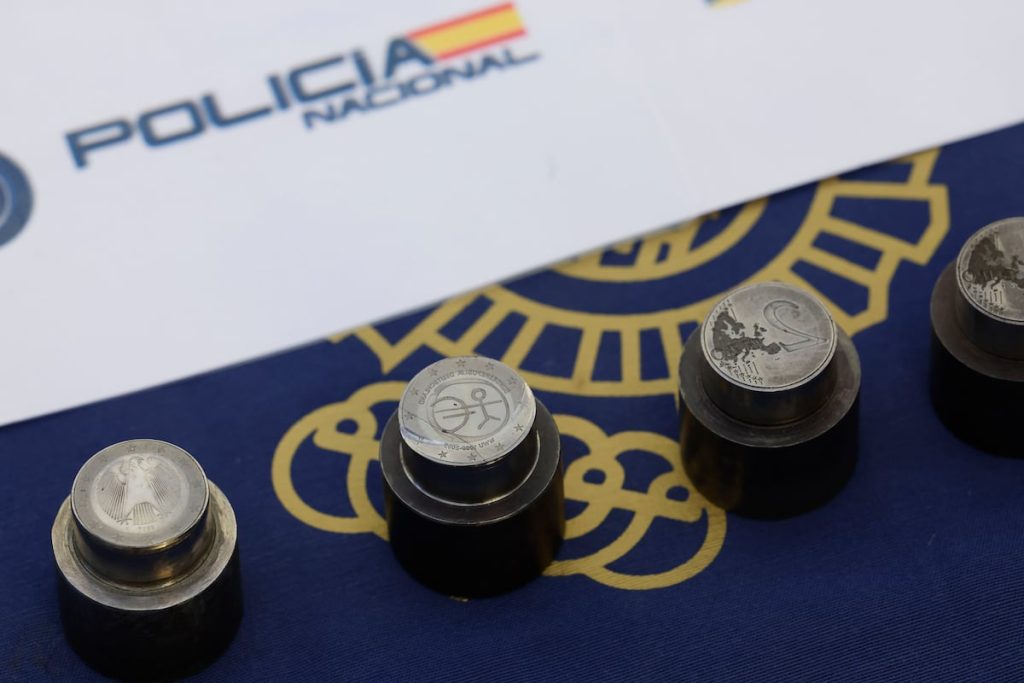The National Police and the Mossos d’Esquadra have dismantled the most important workshop for the production of counterfeit two-euro coins in Europe in the last decade this week. Located in Villacañas (Toledo) and managed by a network of Chinese citizens, it is estimated that since 2018, at least 100,000 coins have been put into circulation in Spain and 400,000 in Europe. While the European Central Bank is responsible for approving the volume of coins that eurozone countries can issue, coins remain a national competence. The main purpose of minting and issuing two-euro coins, according to the National Mint and Stamp Factory (FNMT), is “the cultural and artistic dissemination and commemoration of important events.” The dismantled workshop could produce up to 900 coins a day with machines that made very little noise during operation to avoid detection.
Since the creation of the euro, the Bank of Spain has issued and minted 575 million two-euro coins. However, once in circulation, it cannot be ensured that they are only in Spain because, belonging to a monetary union, euro coins put into circulation by any central bank of the Eurosystem can freely circulate in any of the eurozone countries, explain from the Bank of Spain. The fight against counterfeiting in Spain is based on three fundamental pillars that cooperate with each other. Firstly, the technical pillar involves collecting, analyzing, and cataloguing information on counterfeit banknotes and coins, a task that falls on the Bank of Spain, specifically on the National Analysis Center (CNA) and the National Coin Analysis Center (CNAM). This technical and statistical information is also communicated to the Eurosystem and to the security forces, specifically to the Investigation Brigade of the Bank of Spain belonging to the National Police.
Secondly, the police pillar consists of investigating and prosecuting crimes related to the counterfeiting of the euro, a crucial task to maintain the integrity of our currency. This task falls on the Investigation Brigade of the Bank of Spain (BIBE). Lastly, the judicial pillar is supported by the Penal Code, which establishes penalties of 8 to 12 years for anyone who counterfeits or alters euro banknotes or coins, as well as fines of up to 10 times their value. It is also considered a crime, with imprisonment or fines, to distribute or sell counterfeit currency after knowing its falseness, even if it was received in good faith.
According to data from the Bank of Spain, in 2023, 33,068 counterfeit coins were detected, of which 30,664 were two-euro coins, 1,274 were one euro coins, and the rest were 50-cent coins. The number of counterfeit coins detected last year is 25% higher than in 2022, although they do not reach the record set in 2018 when nearly 50,000 coins were detected, 48,031 of which were two-euro coins. Since 2017, 253,388 counterfeit coins were detected, of which 239,000 were two-euro coins.
To identify whether a coin is authentic or not, the Bank of Spain has a method called the five-step rule. First, it is essential to ensure that it is not a coin from a country outside the Eurosystem. On every one-euro coin, on one face, the coin’s value and the word “euro” or “euro cent” appear, along with the map of Europe. On the other face, the minting year and an image identifying the issuing country surrounded by the 12 stars of the European flag on the outer part of the coin. Secondly, alignment must be checked by holding the coin between fingers and rotating it. The images on both faces should be correctly aligned vertically. This is called coin alignment.
Thirdly, concordance is important. Starting from 2007, the design of the map on the common face slightly changes to include the entire European continent and not just EU countries as in the original design. Fourthly, magnetism is a test. One and two-euro coins are slightly magnetic, but only in the center. For this test, any small magnet can be used by bringing it near the center of the coin; after a slight shake, it should detach easily. Low denomination coins (1, 2, 5 cents) are strongly magnetic and do not detach from the magnet. Medium denomination coins (10, 20, 50 cents) are not magnetic at all. Lastly, on one and two-euro coins, the map of Europe should have a slightly rough surface due to the exceptional minting process allowing the relief to remain even after much use.
Financial entities and other economic agents that handle and deliver banknotes and coins to the public have the obligation to withdraw counterfeit euros received from circulation and promptly deliver them to the competent national authorities. Any citizen who receives a suspicious counterfeit banknote or coin should also deliver it to the Bank of Spain, a financial institution, or the police authorities.


